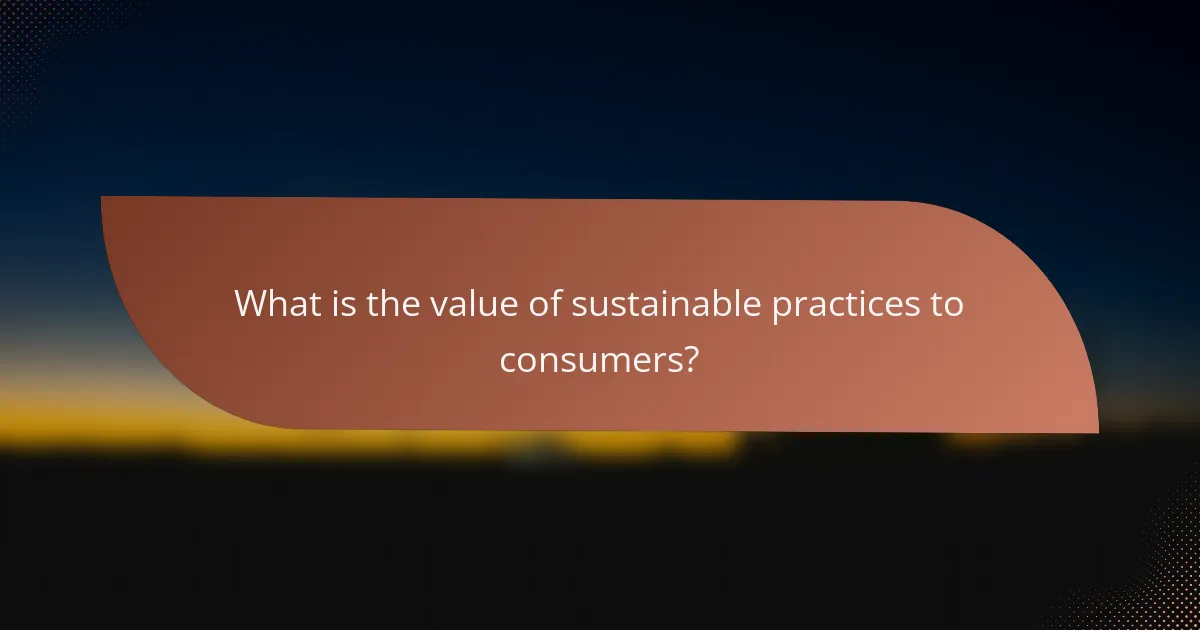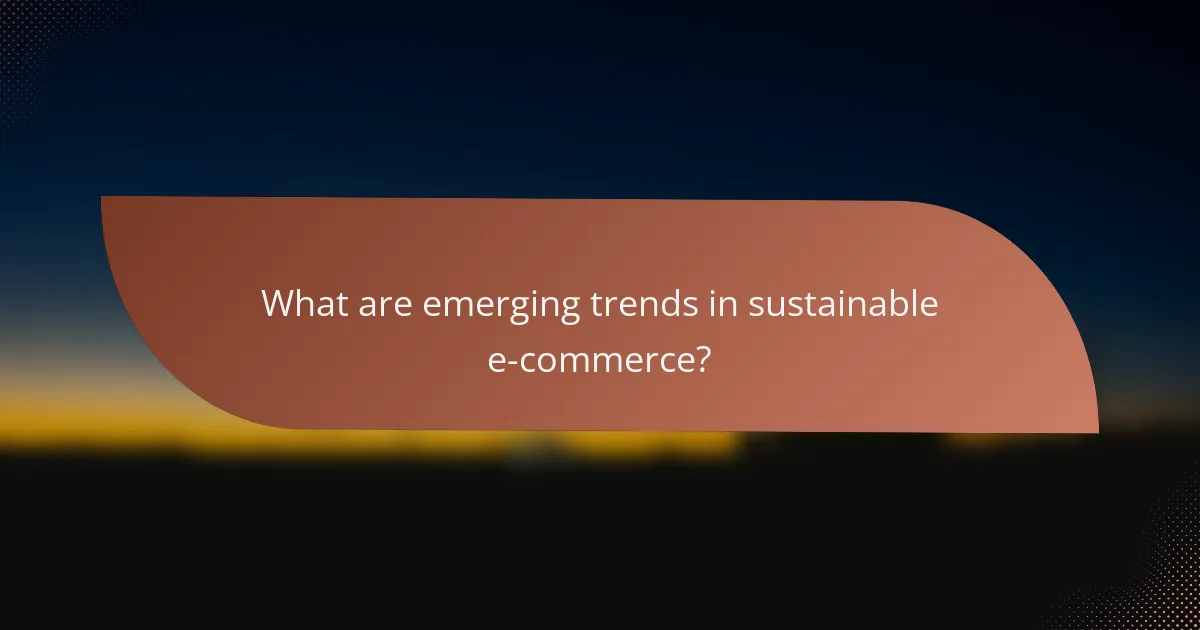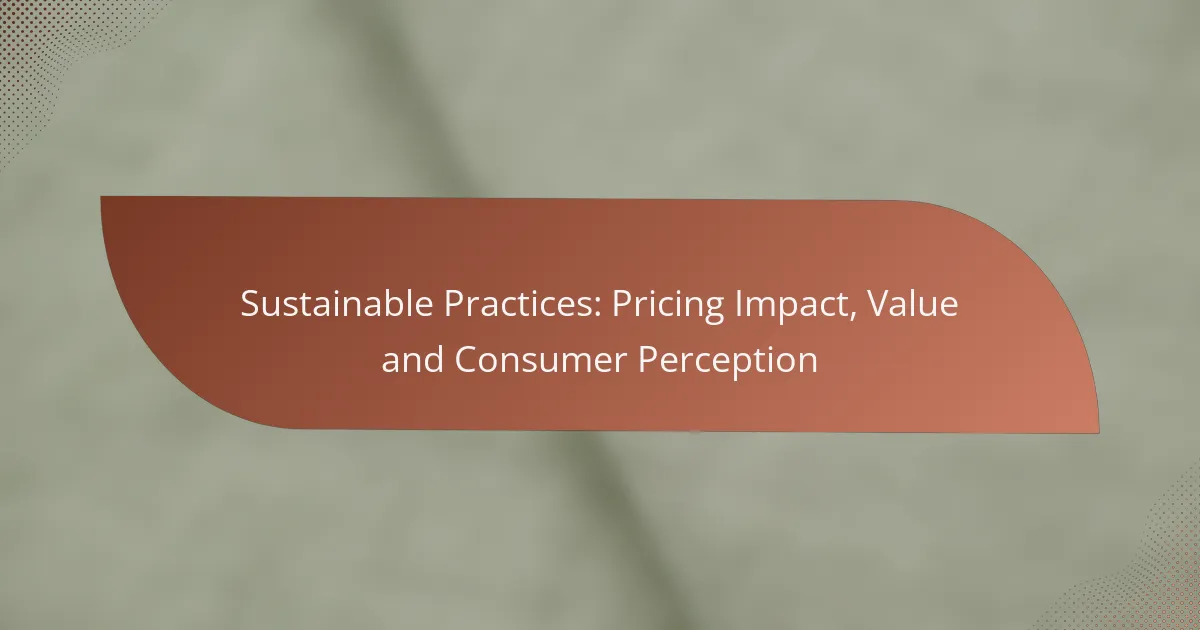Sustainable practices in e-commerce often result in higher prices due to the costs associated with eco-friendly production and materials. However, many consumers are willing to pay a premium for these products, recognizing the added value and aligning their purchases with their ethical values. This positive perception not only enhances brand reputation but also significantly influences consumer purchasing decisions, favoring brands committed to sustainability.

How do sustainable practices affect pricing in e-commerce?
Sustainable practices in e-commerce often lead to higher pricing due to increased production costs and the need for eco-friendly materials. However, these practices can also create value that consumers are willing to pay for, influencing overall market dynamics.
Increased production costs
The shift to sustainable practices typically incurs higher production costs. Eco-friendly materials, ethical labor, and sustainable sourcing can increase expenses by a significant margin, often ranging from 10% to 30% more than conventional methods.
For example, organic cotton may cost more than regular cotton, affecting the final price of clothing items. Brands must balance these costs with pricing strategies to remain competitive while promoting their sustainable initiatives.
Competitive pricing strategies
To manage the impact of increased costs, e-commerce businesses often adopt competitive pricing strategies. This may include offering discounts, bundling products, or implementing loyalty programs to attract price-sensitive consumers.
Some brands may choose to position themselves as premium products, justifying higher prices through marketing that emphasizes sustainability and ethical practices. This approach can help create a niche market willing to pay more for perceived value.
Consumer willingness to pay
Consumer willingness to pay for sustainable products can vary significantly. Research indicates that many consumers are increasingly willing to pay a premium, often between 5% and 15%, for products that are environmentally friendly or ethically sourced.
Factors influencing this willingness include brand reputation, product transparency, and the perceived impact of their purchase on environmental issues. E-commerce businesses should communicate their sustainability efforts clearly to enhance consumer trust and justify higher prices.

What is the value of sustainable practices to consumers?
The value of sustainable practices to consumers lies in their growing preference for environmentally friendly products and services. These practices not only enhance brand reputation but also align with consumers’ ethical values, influencing their purchasing decisions.
Enhanced brand loyalty
Consumers increasingly show loyalty to brands that prioritize sustainability. When a company adopts eco-friendly practices, it fosters a sense of trust and connection with its customers, leading to repeat purchases and long-term relationships.
For example, brands like Patagonia and Seventh Generation have cultivated strong followings by committing to sustainable sourcing and production. This loyalty can translate into higher sales and customer retention rates.
Perceived quality improvements
Sustainable practices often lead consumers to perceive products as higher quality. When brands emphasize eco-friendly materials and ethical production methods, customers associate these attributes with superior craftsmanship and reliability.
For instance, organic food products are frequently viewed as healthier and more nutritious, which can justify a higher price point. This perception can drive consumers to choose sustainable options over conventional ones, even if they cost more.
Long-term savings
Investing in sustainable practices can lead to long-term savings for consumers. Energy-efficient appliances, for example, may have a higher upfront cost but result in lower utility bills over time, making them more economical in the long run.
Additionally, sustainable products often have longer lifespans due to better materials and construction, reducing the need for frequent replacements. Consumers should consider the total cost of ownership rather than just the initial price when evaluating sustainable options.

How do consumers perceive sustainable practices?
Consumers generally view sustainable practices positively, associating them with environmental benefits and ethical considerations. This perception influences their purchasing decisions, often leading them to prefer brands that demonstrate commitment to sustainability.
Positive environmental impact
Many consumers recognize that sustainable practices can significantly reduce environmental harm. For example, products made from recycled materials or those that utilize renewable energy sources are often favored for their lower carbon footprints. This awareness drives a preference for brands that actively promote eco-friendly initiatives.
Additionally, consumers are increasingly concerned about issues like plastic pollution and climate change, leading them to support businesses that implement sustainable practices. Brands that transparently communicate their environmental impact can enhance consumer trust and loyalty.
Social responsibility alignment
Consumers often align their values with brands that prioritize social responsibility. This includes fair labor practices, community engagement, and ethical sourcing of materials. When companies demonstrate a commitment to social issues, they resonate more deeply with consumers who prioritize these values.
For instance, brands that support local communities or contribute to social causes can attract consumers who want their purchases to have a positive social impact. This alignment can lead to increased customer loyalty and a willingness to pay a premium for products that reflect these values.
Influence of marketing
Marketing plays a crucial role in shaping consumer perceptions of sustainable practices. Effective campaigns that highlight a brand’s commitment to sustainability can significantly influence buying behavior. Clear messaging about the benefits of sustainable products often resonates with environmentally conscious consumers.
However, consumers are becoming more discerning about greenwashing, where companies falsely claim to be sustainable. Brands must ensure that their marketing efforts are transparent and backed by genuine practices to build credibility and trust with their audience.

What are the challenges of implementing sustainable practices?
Implementing sustainable practices presents several challenges, including navigating complex supply chains, educating consumers, and ensuring compliance with regulations. These hurdles can impact costs, operational efficiency, and overall effectiveness in achieving sustainability goals.
Supply chain complexities
Supply chain complexities arise from the need to source sustainable materials, which often require extensive vetting of suppliers. Companies must assess the environmental impact of their entire supply chain, from raw material extraction to product delivery, which can be resource-intensive.
Additionally, integrating sustainable practices may lead to increased costs initially, as sustainable materials can be more expensive than conventional options. Businesses should weigh these costs against potential long-term savings and brand loyalty benefits.
Consumer education needs
Educating consumers about the benefits and importance of sustainable practices is crucial for driving demand. Many consumers may not fully understand the value of sustainability, which can lead to resistance to higher prices associated with eco-friendly products.
Effective communication strategies, such as transparent labeling and marketing campaigns, can help bridge this knowledge gap. Companies should focus on highlighting the long-term benefits of sustainability, such as health advantages and environmental preservation, to foster consumer support.
Regulatory compliance
Regulatory compliance is a significant challenge, as businesses must navigate a landscape of local, national, and international regulations regarding sustainability. These regulations can vary widely, impacting how companies operate and report their sustainability efforts.
To ensure compliance, businesses should stay informed about relevant laws and standards, such as the EU’s Green Deal or the U.S. Environmental Protection Agency guidelines. Regular audits and consultations with legal experts can help mitigate risks associated with non-compliance.

How can e-commerce businesses communicate sustainability effectively?
E-commerce businesses can communicate sustainability effectively by prioritizing transparency, showcasing certifications, and employing engaging storytelling. These strategies help build trust with consumers and enhance the perceived value of sustainable practices.
Transparency in sourcing
Transparency in sourcing involves openly sharing information about where and how products are made. Businesses should provide details on the materials used, the production process, and the ethical practices of suppliers. This clarity can significantly influence consumer trust and loyalty.
For example, brands can include information about sourcing on product pages or in dedicated sections of their websites. Highlighting local sourcing or fair trade practices can resonate well with environmentally conscious consumers.
Highlighting certifications
Highlighting certifications is crucial for establishing credibility in sustainability claims. Certifications from recognized organizations, such as Fair Trade, USDA Organic, or Energy Star, signal to consumers that a product meets specific environmental and ethical standards.
Businesses should prominently display these certifications on product labels and marketing materials. This not only informs consumers but also differentiates products in a competitive market, potentially justifying higher price points.
Engaging storytelling
Engaging storytelling connects consumers emotionally to a brand’s sustainability journey. Sharing narratives about the brand’s mission, the impact of sustainable practices, and the stories of artisans or communities involved can create a personal connection.
Utilizing various formats, such as videos, blog posts, or social media campaigns, can enhance this storytelling. For instance, a short documentary about the production process can effectively illustrate the brand’s commitment to sustainability and engage consumers on a deeper level.

What frameworks exist for evaluating sustainable practices?
Several frameworks help assess sustainable practices, focusing on environmental, social, and economic impacts. These methodologies provide structured approaches to measure sustainability and guide decision-making in various sectors.
Life Cycle Assessment (LCA)
Life Cycle Assessment (LCA) evaluates the environmental impacts of a product throughout its entire life cycle, from raw material extraction to disposal. This comprehensive approach considers factors such as resource consumption, emissions, and waste generation at each stage.
When conducting an LCA, it’s essential to define the goal and scope clearly, gather data on inputs and outputs, and analyze the results to identify areas for improvement. Common pitfalls include overlooking certain life cycle stages or failing to account for indirect impacts.
Triple Bottom Line (TBL)
The Triple Bottom Line (TBL) framework assesses sustainability by measuring three key dimensions: social, environmental, and economic performance. This holistic approach encourages businesses to consider not just profits but also their impact on people and the planet.
To implement TBL effectively, organizations should establish metrics for each dimension, such as community engagement for social impact, carbon footprint for environmental performance, and financial health for economic viability. Balancing these aspects can be challenging, but it fosters long-term sustainability and stakeholder trust.

What are emerging trends in sustainable e-commerce?
Emerging trends in sustainable e-commerce focus on eco-friendly practices, consumer demand for transparency, and innovative technologies that reduce environmental impact. Businesses are increasingly adopting sustainable supply chains, green packaging, and carbon offset initiatives to meet consumer expectations and regulatory requirements.
Consumer Demand for Transparency
Consumers are increasingly seeking transparency regarding the sustainability of products and brands. They want to know how items are sourced, manufactured, and delivered, often favoring companies that provide clear information about their environmental impact. This trend has led to the rise of certifications and labels that indicate sustainable practices.
For example, brands that display certifications like Fair Trade or Organic can attract environmentally conscious shoppers. Providing detailed product information on websites can enhance trust and encourage purchases, as consumers are willing to pay a premium for products that align with their values.
Innovative Packaging Solutions
Innovative packaging solutions are becoming a key focus in sustainable e-commerce. Companies are exploring biodegradable materials, reusable packaging, and minimalistic designs that reduce waste. This shift not only appeals to eco-conscious consumers but also helps brands lower shipping costs and improve efficiency.
For instance, brands like Loop offer a circular shopping system where packaging is designed to be returned and reused. This approach not only minimizes waste but also fosters customer loyalty by engaging consumers in sustainable practices.
Carbon Neutral Shipping Options
Carbon neutral shipping options are gaining traction as e-commerce businesses look to reduce their carbon footprints. Many companies are partnering with logistics providers that offer carbon offset programs, allowing them to neutralize the emissions produced during delivery. This practice is becoming a selling point for environmentally aware consumers.
For example, retailers may offer customers the option to select carbon-neutral shipping at checkout for a small fee, which can enhance their brand’s sustainability image. It is essential for businesses to communicate these options clearly to consumers to increase uptake and satisfaction.
